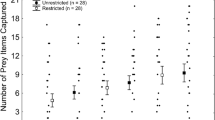Abstract
Although optimal investment theory would be similarly applicable to eusocial insects to maximize colony reproductive outputs, directly distinguishing an amount of investment in each larva should be a difficult task for workers because of the characteristics of group living. Thus, it is expected that workers adjust brood care by using a cue or signal conveying information of larval status. In termites, which are typical group of eusocial insects, there are nevertheless few direct observations on worker brood care and little is known about cues inducing worker feeding. I show here that a Japanese subterranean termite Reticulitermes speratus uses an overt food solicitation by larva, “pecking”, as a cue for worker feeding. Direct observations demonstrated that workers feed larvae in response to larval pecking. Furthermore, nutritional experiments showed that larvae exhibited pecking more frequently when their nutrient status is lower; hence, pecking may be an honest reflection of larval hunger status. These results indicate that workers can feed more starved larvae than less starved ones because pecking honestly reflects larval hunger state. That is, feeding in response to pecking should standardize the total amount of food intake of each larva and help a termite colony make worker investment efficient.



Similar content being viewed by others
References
Brian MV (1977) Ants. Collins, Glasgow
Cabrera BJ, Rust MK (1999) Caste differences in feeding and trophallaxis in the western drywood termite, Incistermes minor (Hagen) (Isoptera, Kalotermitidae). Insect Soc 46:244–249
Cassill DL, Tschinkel WR (1995) Allocation of liquid food to larvae via trophallaxis in colonies of the fire ant, Solenopsis invicta. Anim Behav 50:801–813
Clutton-Brock TH (1991) The evolution of parental care. Princeton University Press, Princeton
Creemers B, Billen J, Gobin B (2003) Larval begging behaviour in the ant Myrmica rubra. Ethol Ecol Evol 15:261–272
Godfray HCJ (1995) Evolutionary theory of parent-offspring conflict. Nature 376:133–138
Huang QY, Wang WP, Mo RY, Lei CL (2008) Studies on feeding and trophallaxis in the subterranean termite Odontotermes formosanus using rubidium chloride. Entomol Exp Appl 129:210–215
Ishay J, Schwartz A (1973) Acoustical communication between the members of the oriental hornet (Vespa orientalis) colony. J Acoust Soc Am 63:640–649
Kaptein N, Billen J, Gobin B (2005) Larval begging for food enhances reproductive options in the ponerine ant Gnamptogenys striatula. Anim Behav 69:293–299
Korb J (2005) Regulation of sexual development in the basal termite Cryptotermes secundus: mutilation, pheromonal manipulation or honest signal? Naturwissenschaften 92:45–49
LaFage JP, Nutting WL (1978) Nutrient dynamics of termites. In: Brian MV (ed) Production ecology of ants and termites. Cambridge University Press, Cambridge, pp 165–232
Lainé LV, Wright DJ (2003) The life cycle of Reticulitermes spp. (Isoptera: Rhinotermitidae): what do we know? Bull Entomol Res 93:267–278
Le Conte Y, Sreng L, Poitout SH (1995) Brood pheromone can modulate the feeding behavior of Apis mellifera Workers (Hymenoptera: Apidae). J Econ Entomol 88:798–804
Machida M, Kitade O, Miura T, Matsumoto T (2001) Nitrogen recycling through proctodeal trophallaxis in the Japanese damp-wood termite Hodotermopsis japonica (Isoptera, Termopsidae). Insect Soc 48:52–56
Matsuura M, Yamane S (1990) Biology of the Vespine wasps. Springer, Berlin
McMahan EA (1969) Feeding relationships and radioactive techniques. In: Krishna K, Weesner FM (eds) Biology of termites, vol 1. Academic, New York, pp 387–406
O’Neal J, Markin GP (1973) Brood nutrition and parental relationships of the imported red fire ant Solenopsis invicta. J Georgia Entomol Soc 8:294–303
Rosengaus RB, Traniello JFA (2001) Disease susceptibility and the adaptive nature of colony demography in the dampwood termite Zootermopsis angusticollis. Behav Ecol Sociobiol 50:546–556
Shellman-Reeve JS (1990) Dynamics of biparental care in the dampwood termite, Zootermopsis nevadensis (Hagen): response to nitrogen availability. Behav Ecol Sociobiol 26:389–397
Smiseth PT, Moore AJ (2002) Does resource availability affect offspring begging and parental provisioning in a partially begging species? Anim Behav 63:577–585
Smith CC, Fretwell SD (1974) The optimal balance between size and number of offspring. Am Nat 108:499–506
Takematsu Y (1992) Biometrical study on the development of the castes in Reticulitermes speratus (Isoptera, Rhinotermitidae). Jpn J Entomol 60:67–76
Thorne BL, Traniello JFA (2003) Comparative social biology of basal taxa of ants and termites. Annu Rev Entomol 48:283–306
Trivers RL (1974) Parent–offspring conflict. Am Zool 14:249–264
Wilson EO (1971) The insect societies. Harvard University Press, Cambridge
Yanagawa A, Shimizu S (2005) Defense strategy of the termite, Coptotermes formosanus Shiraki to entomophatogenic fungi. Jpn J Env Entomol Z 16:17–22
Yanagawa A, Yokohari F, Shimizu S (2009) The role of antennae in removing entomopathogenic fungi from cuticle of the termite, Coptotermes formosanus. J Insect Sci 9:6
Acknowledgments
I thank Dr. Kenji Fujisaki for help with the study. I also thank Prof. Kenji Matsuura for reading and helpful comments on the manuscript. This study was partly supported by the 21st century COE Program for Innovative Food and Environmental Studies Pioneered by Entomomimetic Sciences, from the Ministry of Education, Culture, Sports, Science, and Technology of Japan, and a Research Fellowship for Young Scientists from the Japan Society for the Promotion of Science (JSPS).
Author information
Authors and Affiliations
Corresponding author
Electronic supplementary material
Below is the link to the electronic supplementary material.
Supplementary material 1 (MPG 2016 kb)
Supplementary material 2 (MPG 2294 kb)
About this article
Cite this article
Kawatsu, K. Effect of nutritional condition on larval food requisition behavior in a subterranean termite Reticulitermes speratus (Isoptera: Rhinotermitidae). J Ethol 31, 17–22 (2013). https://doi.org/10.1007/s10164-012-0343-z
Received:
Accepted:
Published:
Issue Date:
DOI: https://doi.org/10.1007/s10164-012-0343-z




